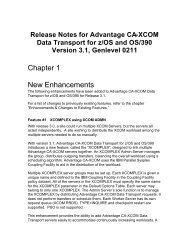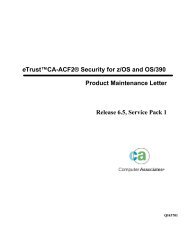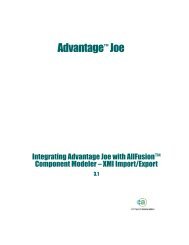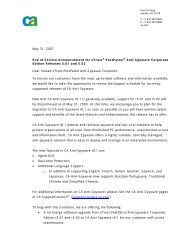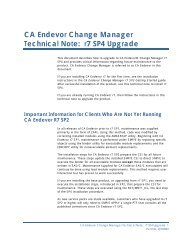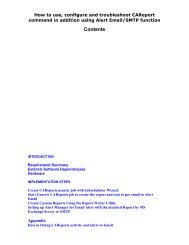eTrust CA-Top Secret Security for z/OS and OS ... - SupportConnect
eTrust CA-Top Secret Security for z/OS and OS ... - SupportConnect
eTrust CA-Top Secret Security for z/OS and OS ... - SupportConnect
- No tags were found...
Create successful ePaper yourself
Turn your PDF publications into a flip-book with our unique Google optimized e-Paper software.
<strong>eTrust</strong> <strong>CA</strong>-<strong>Top</strong> <strong>Secret</strong> <strong>and</strong> the SYSPLEX XCF Function<strong>eTrust</strong> <strong>CA</strong>-<strong>Top</strong> <strong>Secret</strong> <strong>and</strong> the SYSPLEX XCF FunctionXCF message routing allows <strong>eTrust</strong> <strong>CA</strong>-<strong>Top</strong> <strong>Secret</strong> operator comm<strong>and</strong>s to besent to all other <strong>eTrust</strong> <strong>CA</strong>-<strong>Top</strong> <strong>Secret</strong> systems in the sysplex that are defined tothe same group. This allows one <strong>eTrust</strong> <strong>CA</strong>-<strong>Top</strong> <strong>Secret</strong> system to update securitycontrol in<strong>for</strong>mation <strong>and</strong> automatically send the in<strong>for</strong>mation to the other <strong>eTrust</strong><strong>CA</strong>-<strong>Top</strong> <strong>Secret</strong> systems in the sysplex. This provides critical datasynchronization on all systems without operator intervention.The group-name, defined by the SYSPLEX control option, defines the group thata <strong>eTrust</strong> <strong>CA</strong>-<strong>Top</strong> <strong>Secret</strong> system "joins" when the sysplex is started. If there areany other <strong>eTrust</strong> <strong>CA</strong>-<strong>Top</strong> <strong>Secret</strong> systems that have joined the same group <strong>and</strong> the"send" comm<strong>and</strong> has been specified, the TSS comm<strong>and</strong> is sent to those systems.The TSS comm<strong>and</strong> is then processed on the remote <strong>eTrust</strong> <strong>CA</strong>-<strong>Top</strong> <strong>Secret</strong>systems as if it was entered locally.Note: In addition to being defined to the same group, the user must haveCONSOLE authority on all other systems in the sysplex so that the TSScomm<strong>and</strong>s can be properly processed.XCF(*) Control OptionXCF(*) is the <strong>eTrust</strong> <strong>CA</strong>-<strong>Top</strong> <strong>Secret</strong> "send" comm<strong>and</strong> <strong>for</strong> routing in<strong>for</strong>mation toremote systems in the sysplex. The syntax is XCF(*) <strong>and</strong> must be entered as thelast parameter on the TSS MODIFY comm<strong>and</strong>:TSS MODIFY (VTHRESH(10,NOT),XCF(*))This comm<strong>and</strong> illustrates how XCF(*) is used on a TSS MODIFY comm<strong>and</strong> toupdate the violation threshold on all systems in a group on a sysplex with theVTHRESH control option. If the comm<strong>and</strong> is successful, the following message isdisplayed at the sending system.TSS9718I MODIFY COMMAND SENT VIA XCF TO ALL CONNECTEDSYSTEMS IN THIS SYSPLEXFor more details, see the Control Options Guide.Controlling Access to XCF PoliciesIBM provides an administrative utility, IXCMIAPU, to modify, add or deletepolicy data from the ARM, CFRM, LOGR or SFM data sets. Use of this utility iscontrolled by the FACILITY class resource MVSADMIN. <strong>eTrust</strong> <strong>CA</strong>-<strong>Top</strong> <strong>Secret</strong>implementation of the FACILITY class is done using the IBMFAC resource class.Using the Sysplex Coupling Facility 3–5





